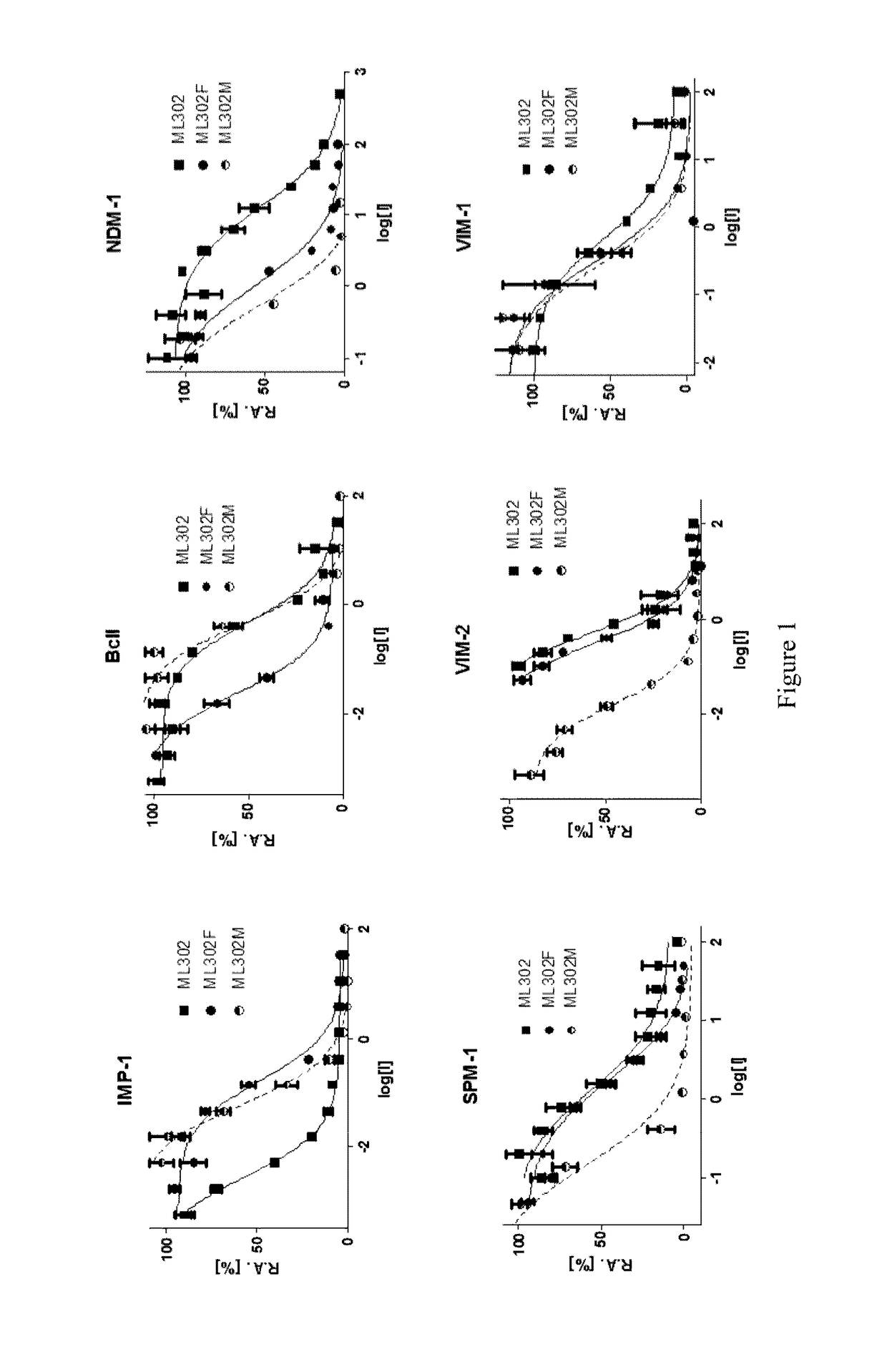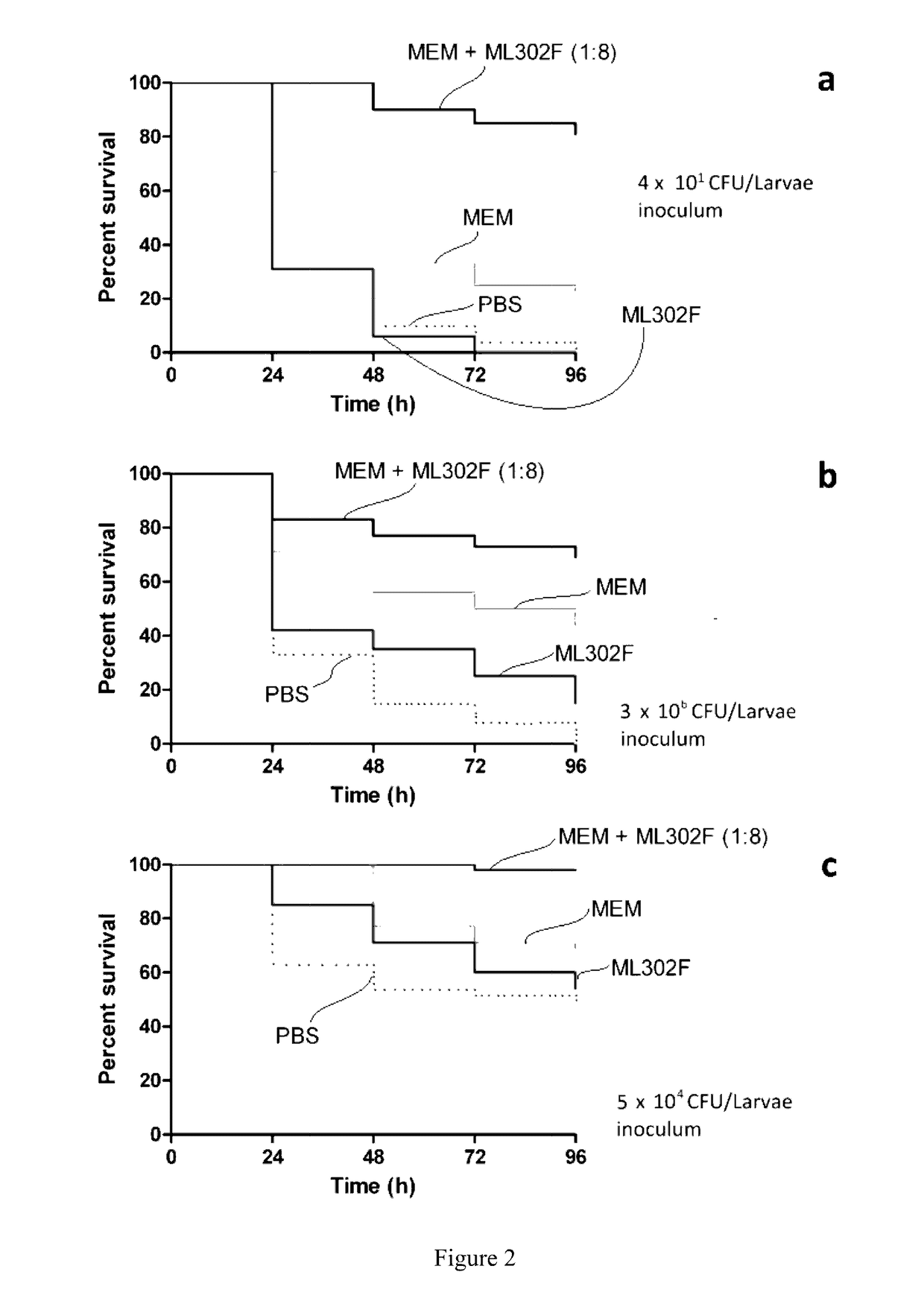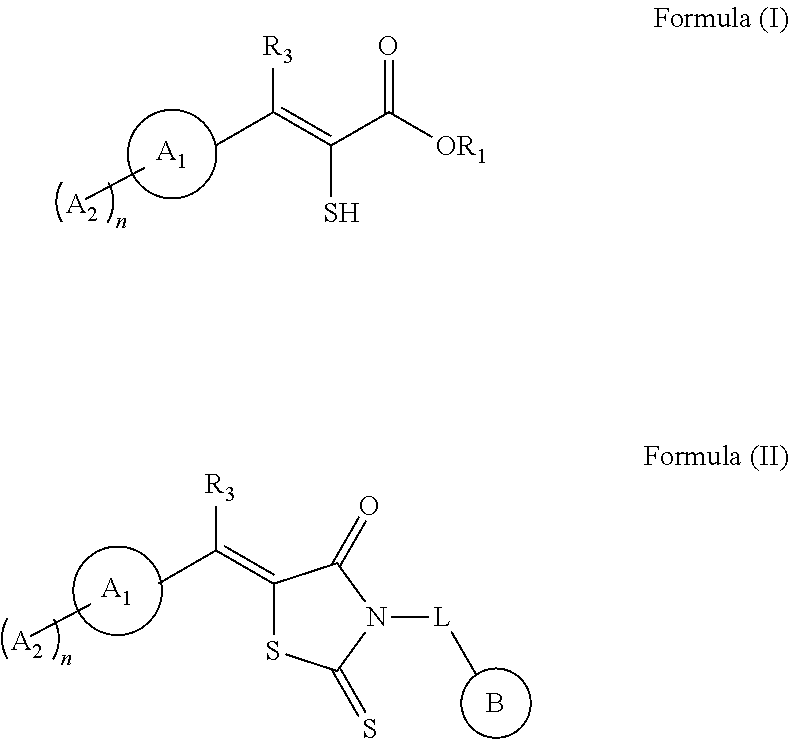Beta Lactamase Inhibitors
a technology of beta lactamase and inhibitors, which is applied in the field of compounds, can solve the problems of no clinically useful inhibitors of the class b metallo-bls (mbls), and compromised use of -lactams
- Summary
- Abstract
- Description
- Claims
- Application Information
AI Technical Summary
Benefits of technology
Problems solved by technology
Method used
Image
Examples
example 1
ylpiperazin-1-yl)-2-(4-oxo-2-thioxo-5-(2,3,6-trichlorobenzylidene)thiazolidin-3-yl)acetamide (E / Z mixture (1:3)) (ML302)
[0111]
[0112]A solution of 1 (381 mg, 1.0 mmol) and Bis(2-oxo-3-oxazolidinyl)phosphonic chloride (BOP-Cl, 350 mg, 1.2 mmol, 1.2 equiv) in CH2Cl2 (10 mL) was cooled to 0° C. using an ice / water bath under an inert atmosphere. Freshly distilled triethylamine (Et3N, 168 μL, 1.2 mmol, 1.2 equiv) was added and the solution was allowed to stir at 0° C. for 30 min. 1-Amino-4-methyl-piperazine (145 μL, 1.2 mmol, 1.2 equiv,) was added and the temperature was raised to r.t. after which the reaction was stirred overnight. The crude product, obtained by removal of dichloromethane in vacuo, was than purified by flash chromatography (CH2Cl2 / MeOH 9:1) to give compound ML302 as a non-separated mixture of E / Z isomers in a 1:3 ratio (373 mg, 78%) as a yellow solid. TLC (CH2Cl2 / MeOH 9:1) Rf=0.35. 1H NMR (400 MHz, CDCl3) δ (assigned for the major isomer)=7.72 (s, 1H), 7.47 (dd, J=8.5, 0...
example 2
o-3-(2,3,6-trichlorophenyl)acrylic acid (E / Z mixture (1:4) (ML302F)
[0113]
[0114]Compound ML302 (240 mg, 0.5 mmol) was dissolved in 1M NaOH (4 mL) upon which a colour change to deep red was observed. The clear reaction mixture was warmed to 60° C., then stirred for 45 min (the reaction colour changes from deep red to yellow) when consumption of starting material was observed. The reaction mixture was cooled to room temperature and subsequently carefully acidified with 1M HCl (5 mL). A white precipitate was formed and collected by centrifugation (4000 g / 10 min). After removal of the liquid phase the white solid was resuspended in H2O (2 mL) and again collected by centrifugation. This process was repeated twice. The obtained solid was dried under high vacuum overnight. The product was obtained as an inseparable mixture of E / Z isomers in a 1:4 ratio as an off-white solid (40 mg, 28%). TLC (CH2Cl2 / MeOH 4:1) Rf=0.67. 1H NMR (400 MHz, CDCl3) δ (assigned for the major isomer)=7.69 (s, 1H), 7...
example 3
[0118]Screening assays to determine kinetic data and IC50 values for ML302F, ML302 and a mixture of ML302 and ML302F (herein ML302M) were carried out as described by van Berkel, S. S. et al in J Med. Chem. 56, 6945-6953 (2013). The experiments were performed by using a NovaStar microplate reader (using path length correction) and were performed at r.t. (24-25° C.). All enzymes and substrates were dissolved in the assay buffer: 50 mM HEPES-NaOH buffer (pH 7.2) supplemented with 1 μg / mL BSA (to minimize the denaturation of the enzyme), 1 μM ZnSO4 and 0.01% Triton 100. Screening was carried out against a panel of MBLs including NDM-1, VIM-1, VIM-2, SPM-1 (Sao Paulo MBL-1) and IMP-1 and the non-clinically relevant model MBL Bacillus cereus (BcII).
[0119]The kinetic values determined were the means from at least three independent measurements. At least six different concentrations of the substrate or inhibitor were used to determinate the kinetic parameters (KM, kcat and IC50). Deter...
PUM
| Property | Measurement | Unit |
|---|---|---|
| Antimicrobial properties | aaaaa | aaaaa |
Abstract
Description
Claims
Application Information
 Login to View More
Login to View More - R&D
- Intellectual Property
- Life Sciences
- Materials
- Tech Scout
- Unparalleled Data Quality
- Higher Quality Content
- 60% Fewer Hallucinations
Browse by: Latest US Patents, China's latest patents, Technical Efficacy Thesaurus, Application Domain, Technology Topic, Popular Technical Reports.
© 2025 PatSnap. All rights reserved.Legal|Privacy policy|Modern Slavery Act Transparency Statement|Sitemap|About US| Contact US: help@patsnap.com



